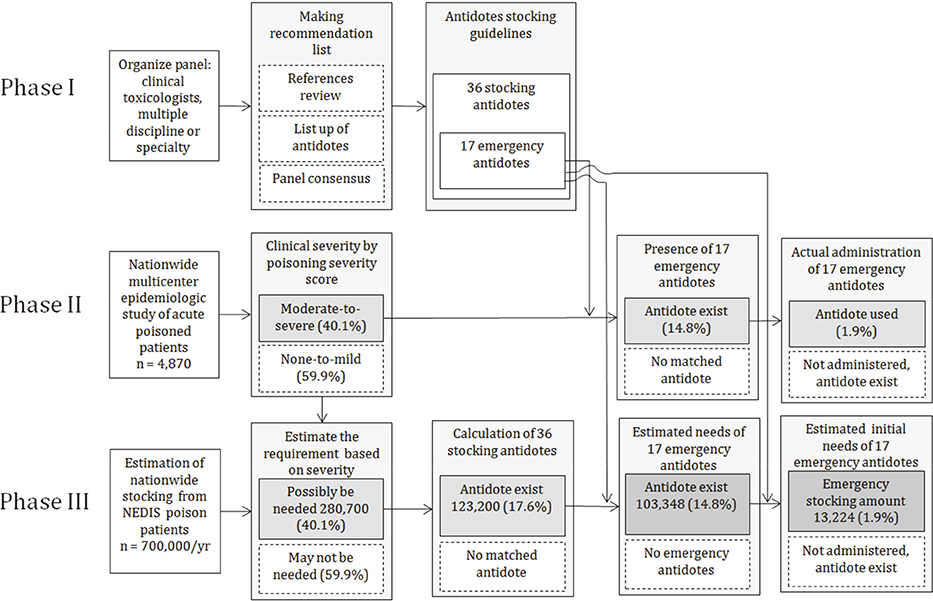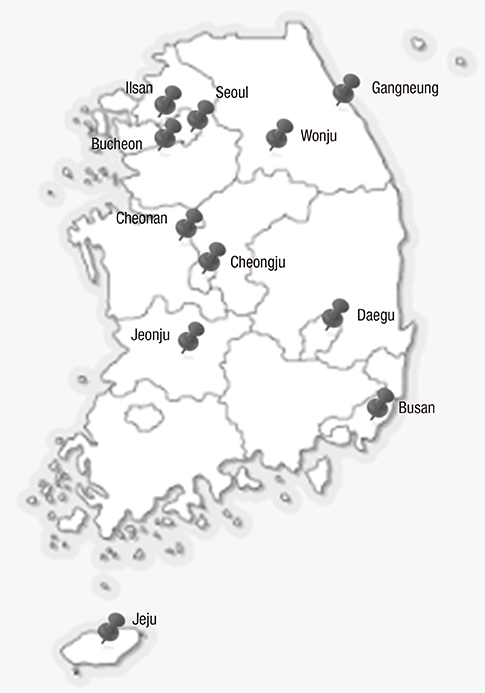J Korean Med Sci.
2014 Nov;29(11):1562-1571. 10.3346/jkms.2014.29.11.1562.
Kind and Estimated Stocking Amount of Antidotes for Initial Treatment for Acute Poisoning at Emergency Medical Centers in Korea
- Affiliations
-
- 1Department of Emergency Medicine, University of Ulsan College of Medicine, Asan Medical Center, Seoul, Korea. bjoh@amc.seoul.kr
- 2The Research Society for Emergency Antidotes Stock and Delivery System in Korea, Seoul, Korea.
- 3Department of Emergency Medicine, Cheju Halla General Hospital, Jeju, Korea.
- 4Department of Emergency Medicine, College of Medicine, Soonchunhyang University Hospital, Bucheon, Korea.
- KMID: 2069940
- DOI: http://doi.org/10.3346/jkms.2014.29.11.1562
Abstract
- Antidotes for toxicological emergencies can be life-saving. However, there is no nationwide estimation of the antidotes stocking amount in Korea. This study tried to estimate the quantities of stocking antidotes at emergency department (ED). An expert panel of clinical toxicologists made a list of 18 emergency antidotes. The quantity was estimated by comparing the antidote utilization frequency in a multicenter epidemiological study and the nation-wide EDs' data of National Emergency Department Information System (NEDIS). In an epidemiological study of 11 nationwide EDs from January 2009 to December 2010, only 92 (1.9%) patients had been administered emergency antidotes except activated charcoal among 4,870 cases of acute adult poisoning patients. Comparing with NEDIS data, about 1,400,000 patients visited the 124 EDs nationwide due to acute poisoning and about 103,348 adult doses of the 18 emergency antidotes may be required considering poisoning severity score. Of these, 13,224 (1.9%) adult doses of emergency antidotes (575 of atropine, 144 of calcium gluconate or other calcium salts, 2,587 of flumazenil, 3,450 of N-acetylcysteine, 5,893 of pralidoxime, 287 of hydroxocobalamin, 144 of sodium nitrite, and 144 of sodium thiosulfate) would be needed for maintaining the present level of initial treatment with emergency antidotes at EDs in Korea.
Keyword
MeSH Terms
Figure
Reference
-
1. Korea National Statistical Office. Annual report on the cause of death statistics: based on vital registration in year 2011. Daejeon: Statistics Korea;2010.2. Centers for Disease Control and Prevention (CDC). Unintentional poisoning deaths: United States, 1999-2004. MMWR Morb Mortal Wkly Rep. 2007; 56:93–96.3. Bronstein AC, Spyker DA, Cantilena LR Jr, Green JL, Rumack BH, Giffin SL. 2009 Annual Report of the American Association of Poison Control Centers' National Poison Data System (NPDS): 27th Annual Report. Clin Toxicol (Phila). 2010; 48:979–1178.4. Dart RC, Stark Y, Fulton B, Koziol-McLain J, Lowenstein SR. Insufficient stocking of poisoning antidotes in hospital pharmacies. JAMA. 1996; 276:1508–1510.5. Dart RC, Borron SW, Caravati EM, Cobaugh DJ, Curry SC, Falk JL, Goldfrank L, Gorman SE, Groft S, Heard K, et al. Expert consensus guidelines for stocking of antidotes in hospitals that provide emergency care. Ann Emerg Med. 2009; 54:386–394.6. Ong HC, Yang CC, Deng JF. Inadequate stocking of antidotes in Taiwan: is it a serious problem? J Toxicol Clin Toxicol. 2000; 38:21–28.7. Gorman SK, Zed PJ, Purssell RA, Brubacher J, Willis GA. Antidote stocking in British Columbia hospitals. CJEM. 2003; 5:12–17.8. Hrubý K. Availability of antidotes in hospital pharmacies in the Czech Republic. Ceska Slov Farm. 2003; 52:231–240.9. Jacobsen P, Kristensen TR, Jensen K. Availability of antidotes in Denmark. Ugeskr Laeger. 2004; 166:4257–4260.10. World Health Organization. World directory of poison centres, 6 February 2012. accessed on 9 January 2013. Available at http://apps.who.int/poisoncentres/.11. Persson HE, Sjöberg GK, Haines JA, Pronczuk de Garbino J. Poisoning severity score. Grading of acute poisoning. J Toxicol Clin Toxicol. 1998; 36:205–213.12. Pronczuk de Garbino J, Haines JA, Jacobsen D, Meredith T. Evaluation of antidotes: activities of the International Programme on Chemical Safety. J Toxicol Clin Toxicol. 1997; 35:333–343.13. Dart RC, Goldfrank LR, Chyka PA, Lotzer D, Woolf AD, McNally J, Snodgrass WR, Olson KR, Scharman E, Geller RJ, et al. Combined evidence-based literature analysis and consensus guidelines for stocking of emergency antidotes in the United States. Ann Emerg Med. 2000; 36:126–132.14. Wolf SJ, Heard K, Sloan EP, Jagoda AS. American College of Emergency Physicians. Clinical policy: critical issues in the management of patients presenting to the emergency department with acetaminophen overdose. Ann Emerg Med. 2007; 50:292–313.15. Wiens MO, Zed PJ, Lepik KJ, Abu-Laban RB, Brubacher JR, Gorman SK, Kent DA, Purssell RA. Adequacy of antidote stocking in British Columbia hospitals: the 2005 Antidote Stocking Study. CJEM. 2006; 8:409–416.16. Burillo-Putze G, Munne P, Duenas A, Pinillos MA, Naveiro JM, Cobo J, Alonso J. Clinical Toxicology Working Group. Spanish Society of Emergency Medicine (SEMESTOX). National multicentre study of acute intoxication in emergency departments of Spain. Eur J Emerg Med. 2003; 10:101–104.17. Solheim L, Andrew E, Jacobsen D. Antidote availability in Norway. Tidsskr Nor Laegeforen. 2002; 122:1111–1113.18. Plataki M, Anatoliotakis N, Tzanakis N, Assithianakis P, Tsatsakis AM, Bouros D. Availability of antidotes in hospital pharmacies in Greece. Vet Hum Toxicol. 2001; 43:103–105.19. Marraffa JM, Cohen V, Howland MA. Antidotes for toxicological emergencies: a practical review. Am J Health Syst Pharm. 2012; 69:199–212.20. Blizzard JC, Michels JE, Richardson WH, Reeder CE, Schulz RM, Holstege CP. Cost-benefit analysis of a regional poison center. Clin Toxicol (Phila). 2008; 46:450–456.21. Bronstein AC, Spyker DA, Cantilena LR Jr, Rumack BH, Dart RC. 2011 Annual report of the American Association of Poison Control Centers' National Poison Data System (NPDS): 29th Annual Report. Clin Toxicol (Phila). 2012; 50:911–1164.22. Sivilotti ML, Eisen JS, Lee JS, Peterson RG. Can emergency departments not afford to carry essential antidotes. CJEM. 2002; 4:23–33.23. Paulozzi LJ, Xi Y. Recent changes in drug poisoning mortality in the United States by urban-rural status and by drug type. Pharmacoepidemiol Drug Saf. 2008; 17:997–1005.24. Simonsen KW, Normann PT, Ceder G, Vuori E, Thordardottir S, Thelander G, Hansen AC, Teige B, Rollmann D. Fatal poisoning in drug addicts in the Nordic countries in 2007. Forensic Sci Int. 2011; 207:170–176.25. World Health Organization, the United Nations Environment Programme, the International Labour Organisation. Guidelines for poison control. Geneva, Switzerland: World Health Organization;1997. p. 59.
- Full Text Links
- Actions
-
Cited
- CITED
-
- Close
- Share
- Similar articles
-
- The Experiences of the Emergency Antidote Stock and Delivery Service by the Korean Poison Information Center
- Need for stocking of emergency antidotes
- Antidotes Stocking and Delivery for Acute Poisoning Patients at 20 Emergency Departments in Korea 2015–2017
- Significance of the Poisoning Severity Score as a Prognostic Factor in Poisoning
- A Case of Aconite Poisoning Successfully Recovered after Intravenous Fat Emulsion Therapy



